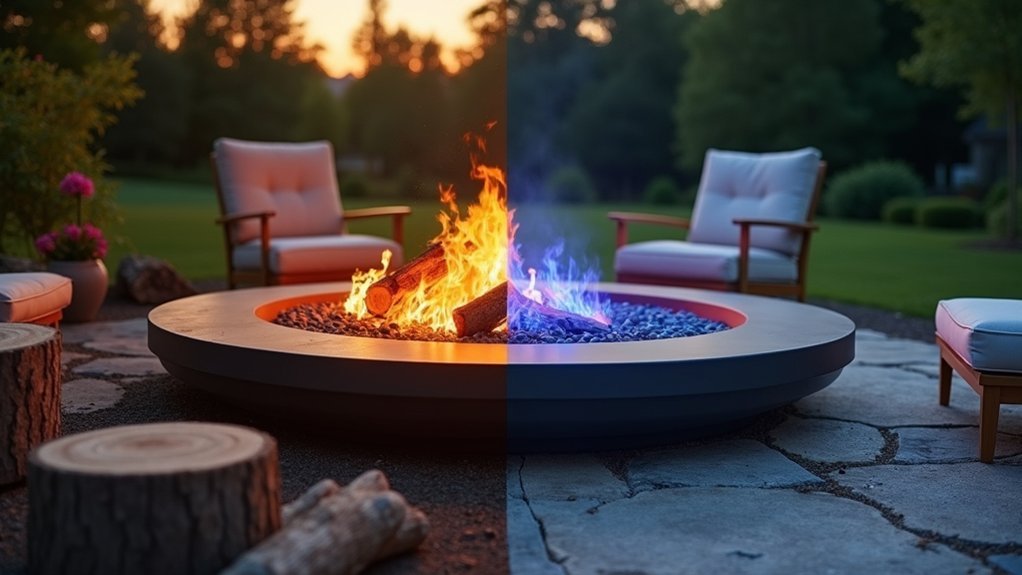You’ll make the right fire pit choice by focusing on three key factors. First, consider your maintenance tolerance—propane offers instant ignition and minimal cleanup, while wood-burning requires ongoing fuel gathering and ash removal. Second, check local regulations since wood-burning pits often face seasonal restrictions that don’t apply to gas models. Third, weigh long-term costs including fuel expenses and maintenance requirements. Understanding these factors will guide you toward the perfect outdoor heating solution for your specific needs.
Consider Your Maintenance Preferences and Convenience Needs

When weighing your fire pit options, you’ll find that maintenance requirements and convenience factors create a stark contrast between propane and wood-burning models.
Propane fire pits offer superior ease of use with instant ignition at the turn of a knob, eliminating fire-building skills and patience requirements. You’ll appreciate minimal cleanup since there’s no ash or soot production, just occasional surface wiping.
Wood-burning fire pits demand regular wood fuel gathering, ash removal, and ongoing fire management throughout use. Your maintenance preferences should guide this decision – propane tanks require simple replacement, while wood fuel needs constant replenishment.
Consider your outdoor space setup and desired environmental impact when choosing between hassle-free propane convenience and traditional wood-burning authenticity.
Evaluate Safety Requirements and Local Regulations
Safety considerations and local regulations greatly impact your fire pit selection process. You’ll need to check local fire codes before installing any outdoor fire system, as many areas restrict wood burning fire pits due to fire hazards in dry climates. Gas fire pits often receive approval during burning bans since they produce controlled flames with minimal smoke.
| Safety Requirements | Wood Burning | Gas Fire Pits |
|---|---|---|
| Burning Restrictions | Often banned during dry seasons | Typically allowed year-round |
| Permit Requirements | Usually not required | May require permits for gas lines |
Position fire pits 10-25 feet from structures per local regulations. Never burn treated wood, as it releases toxic fumes. Gas systems offer safer operation with reduced fire hazards compared to burning wood alternatives.
Compare Long-Term Costs and Environmental Impact

Beyond initial purchase decisions, you’ll face ongoing expenses that markedly differ between wood and gas fire pits over their lifetime.
While wood burning fire pit initial costs range from $300-$1,000 compared to gas fire pits at $800-$3,000, your long-term costs depend on fuel expenses and maintenance requirements.
Initial purchase prices favor wood fire pits, but gas models may prove more economical when factoring in long-term fuel and maintenance expenses.
You’ll spend approximately $14 per firewood pack versus $12 per 1,000 cubic feet of propane.
Gas fire pits offer lower maintenance requirements, eliminating ash cleanup and wood supply management.
Regarding environmental impact, gas fire pits produce fewer emissions, improving air quality.
However, you can choose sustainable fuel options like locally sourced firewood to reduce your wood burning fire pit’s environmental footprint, though gas relies on non-renewable fossil fuels for ongoing expenses.
Frequently Asked Questions
Are Wood-Burning or Propane Fire Pits Better?
You’ll find propane fire pits better for convenience and cleanliness, while wood-burning pits excel for authentic ambiance and heat output. Your choice depends on whether you prioritize ease-of-use or traditional campfire experience.
What Are the Downsides of a Propane Fire Pit?
You’ll face higher ongoing costs, limited cooking options, reduced heat output, and miss the authentic crackling sounds. You’ll also need tank refills and potentially expensive gas line installations for setup.
How Long Will a 20 Lb Propane Tank Run a Fire Pit?
A 20 lb propane tank will run your fire pit for 18-20 hours at 20,000 BTUs per hour, or about 10-11 hours at higher 40,000 BTU settings, depending on flame intensity.
Is It Better to Burn Wood or Propane?
You’ll prefer wood if you want authentic ambiance and higher heat output at lower cost. Choose propane if you prioritize convenience, cleaner burning, and minimal maintenance for your fire pit.





Leave a Reply